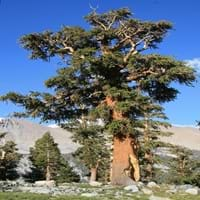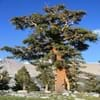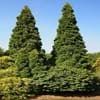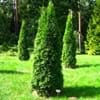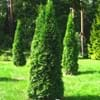Life Span
Perennial
Perennial
Type
Needled or Scaled Evergreen
Flowering Plants, Fruits, Trees
Origin
Europe, Russia/Siberia, Western Asia
Anatolia, Asia, Europe, Iran, Maghreb, Morocco, Norway, The Hiamalayas
Types
not available
Flowering Cherries, Sour Cherries, Sand Cherries, Sweet Cherries, Capulin Cherries
Number of Varieties
Not Available
Habitat
Alpine Meadows, Mediterranean region, Rock outcrops, Slopes, Woodlands
Forest edges, Wild, Woods
USDA Hardiness Zone
5-8
4-8
AHS Heat Zone
Not Available
10-1
Sunset Zone
1 - 7,15 - 17
4, 5, 6, 7, 15, 16, 17
Habit
Pyramidal
Upright/Erect
Flower Color
Not Available
White
Flower Color Modifier
Not Available
Not Available
Fruit Color
Not Available
Red
Leaf Color in Spring
Green
Dark Green
Leaf Color in Summer
Green, Blue Green
Orange
Leaf Color in Fall
Green, Blue Green
Orange
Leaf Color in Winter
Blue Green, Gray Green
Orange
Leaf Shape
Needle like
Oblong
Plant Season
Spring, Summer, Fall, Winter
Spring, Summer
Sunlight
Full Sun
Full Sun, Partial shade
Type of Soil
Loam, Sand
Loamy, Well drained
The pH of Soil
Acidic, Neutral
Slightly Acidic
Soil Drainage
Average
Average
Bloom Time
Late Summer, Spring
Early Spring, Spring
Tolerances
Drought
Heat And Humidity, Not Available
Where to Plant?
Ground
Ground
How to Plant?
Cuttings, Seedlings
Grafting, Seedlings, Transplanting
Plant Maintenance
Medium
Medium
Watering Requirements
Keep ground moist, Keep the Soil well drained, Medium, Requires regular watering
Never Over-water, Over-watering can cause leaf problems or root diseases, Prefer drip-irrigation instead of Over-head watering, Water twice a day in the initial period
In Summer
Lots of watering
Lots of watering
In Spring
Moderate
Moderate
In Winter
Average Water
Average Water
Soil pH
Acidic, Neutral
Slightly Acidic
Soil Type
Loam, Sand
Loamy, Well drained
Soil Drainage Capacity
Average
Average
Sun Exposure
Full Sun
Full Sun, Partial shade
Pruning
Prune once the plant is tall enough, Prune to stimulate growth
Don't prune in the fall, Prune if you want to improve plant shape, Prune in late winter, Remove dead or diseased plant parts, Remove deadheads
Fertilizers
All-Purpose Liquid Fertilizer
All-Purpose Liquid Fertilizer
Pests and Diseases
Adelgids, Bark beetles, Blister Rust, Canker, Sawfly Larvae, Spruce spider mite, White pine weevil
Aphids, Bacterial Canker, Black Knot, Brown Rot, Caterpillars
Plant Tolerance
Drought
Drought
Flowers
Not Available
Yes
Flower Petal Number
Single
Not Available
Foliage Texture
Medium
Not Available
Foliage Sheen
Not Available
Not Available
Attracts
Birds, Insects
Birds
Allergy
Not Available
Swelling in the face
Aesthetic Uses
Beautification, Decorating walls, Ground Cover, Landscape Designing, Mixed Border, Showy Purposes, Used for decorating walls, fences, gates, hedges, etc., Used for making hedges
Showy Purposes
Beauty Benefits
Not Available
Not Available
Environmental Uses
Air purification
Air purification
Medicinal Uses
Not Available
Arthritis, Gout, Kidney problems, Rheumatoid arthritis, Swelling
Part of Plant Used
Not Available
Flowers, Fruits
Other Uses
Application in Furniture, Condiment, Food for animals, Paper pulp, Showy Purposes, Used as Christmas Tree, Used as Ornamental plant, Used for its medicinal properties, Used for Landscaping
Wood is used for making furniture
Used As Indoor Plant
No
No
Used As Outdoor Plant
Yes
Yes
Garden Design
Feature Plant, Screening, Wind Break, Shade Trees
Not Available
Botanical Name
Pinus balfouriana
Prunus avium
Common Name
Foxtail pine
Cherry Tree
In Hindi
foxtail pine
चेरी का पेड़
In German
foxtail Kiefer
Kirschbaum
In French
sétaire pin
Cerisier
In Spanish
pino de cola de zorra
Cerezo
In Greek
αλωπέκουρου πεύκο
κερασιά
In Portuguese
pinho foxtail
árvore de cereja
In Polish
włośnica sosny
wiśniowe drzewo
In Latin
panicum pinus
Cherry
Phylum
Coniferophyta
Magnoliophyta
Class
Pinopsida
Magnoliopsida
Clade
Not Available
Angiosperms, Eudicots, Rosids
Tribe
Pineae
Not Available
Subfamily
Pinoideae
Not Available
Number of Species
Not Available
Importance of Foxtail pine and Cherry Tree
Want to have the most appropriate plant for your garden? You might want to know the importance of Foxtail pine and Cherry Tree. Basically, these two plants vary in many aspects. Compare Foxtail pine and Cherry Tree as they differ in many characteristics such as their life, care, benefits, facts, etc. Every gardener must at least have the slightest clue about the plants he wants to plant in his garden. Compare their benefits, which differ in many ways like facts and uses. The medicinal use of Foxtail pine is Not Available whereas of Cherry Tree is Arthritis, Gout, Kidney problems, Rheumatoid arthritis and Swelling. Foxtail pine has beauty benefits as follows: Not Available while Cherry Tree has beauty benefits as follows: Not Available.
Compare Facts of Foxtail pine vs Cherry Tree
How to choose the best garden plant for your garden depending upon its facts? Here garden plant comparison will help you to solve this query. Compare the facts of Foxtail pine vs Cherry Tree and know which one to choose. As garden plants have benefits and other uses, allergy is also a major drawback of plants for some people. Allergic reactions of Foxtail pine are Not Available whereas of Cherry Tree have Swelling in the face respectively. Having a fruit bearing plant in your garden can be a plus point of your garden. Foxtail pine has no showy fruits and Cherry Tree has showy fruits. Also Foxtail pine is not flowering and Cherry Tree is flowering. You can compare Foxtail pine and Cherry Tree facts and facts of other plants too.
